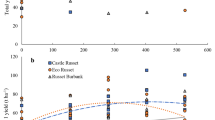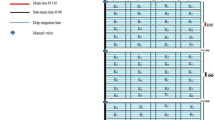Abstract
A soil test value of 112 ppm K in the 0 to 8 in (0 to 20 cm) depth was sufficient to produce a 250 cwt/A (28 T/ha) yield with no response to K fertilization. With a 93 ppm soil test value, potassium fertilizer increased yields in all four varieties tested. These results were obtained from trials at two locations in a seed-growing area in eastern Idaho where soil tests indicated low potassium levels (90 to 100 ppm K). Russet Burbank, Targhee, Nampa, and Butte varieties were included in the study at one location and only Russet Burbank at the second location. Potassium fertilizer treatments included K2O rates of 0, 250, and 5001b/A (0, 280, and 560 kg/ha) for each of the two forms of potassium fertilizer (KC1 and K2SO4). At the time of tuber initiation, a petiole content of 7% K in Russet Burbank was sufficient to produce maximum yields while a petiole content less than 6% K was insufficient. Analysis of petiole samples taken during the season showed that the K content declined rapidly as the season progressed. Potassium chloride generally resulted in higher petiole K levels than did potassium sulfate. Varieties appeared to differ in petiole K levels.
Resumen
En el análisis de suelo, un valor de 112 ppm K en la capa de 0 a 8″ (0 a 20 cm) era suficiente para producir un rendimiento de 250 CWT/A (28 T/ha) sin respuesta a fertilización con K. Con un valor de 93 ppm de K en el análisis de suelo, la fertilización potásica aumentó los rendimientos en las cuatro variedades experimentadas. Estos resultados fueron obtenidos en ensayos realizados en dos localidades en areas de producción de semilla en el Este de Idaho, donde los análisis de suelos indicaban niveles bajos de K (90 a 100 ppm de K).
Las variedades Russet Burbank, Targhee, Nampa y Butte fueron incluídas en el estudio de una localidad y solamente Russet Burbank en la segunda localidad. Los tratamientos de K2O fueron 0, 250 y 500 lb/A (0, 280 y 560 Kg/Ha), para cada una de las dos formas de potasio (C1K y SO4 K2). Al momento de la iniciación de la tuberización, un contenido de 7% K en el peciolo en la variedad Russet Burbank fue suficiente para producir el máximo rendimiento, mientras que menos de 6% de K en el peciolo fue insuficiente. Análisis de las muestras de peciolo tomadas durante la estación, mostraron que el contenido de K decrecía rápidamente a medida que avanzaba la estación. Con cloruro de potasio generalmente resultaba en un mayor contenido de niveles de potasio que con sulfato. Las variedades mostraron diferencias en el contenido de potasio en el peciolo.
Similar content being viewed by others
Literature Cited
Burton, W.G. 1966. The potato. 2nd ed. H. Veenman and Zonen N.V., Wageningen, The Netherlands.
Dwelle, Robert B., G.F. Stallknecht, R.E. McDole, and Joseph J. Pavek. 1977. Effects of soil potash treatment and storage temperature on blackspot bruise susceptibility of fourSolanum tuberosum cultivars. Am Potato J 54:137–146.
Eastwood, Tom and James Watts. 1956. The effect of potash fertilization upon potato chipping quality. IV. Specific gravity. Am Potato J 33:265–268.
McDole, R.E. 1977. Potassium fertilizer trials on coarse textured soils in southeastern Idaho. Am Potato J 55:161–170.
Painter, Charles G., J.P. Jones, R.E. McDole, R.D. Johnson, and R.E. Ohms. 1977. Idaho fertilizer guide: Potatoes. Univ. of Idaho Current Information Series No. 261.
Painter, C.G. and R.E. Ohms. 1967. Potassium needs in Idaho’s potato producing areas. Proceedings of Eighteenth Annual Pacific Northwest Fertilizer Conference. p. 125–130.
Painter, L.I. and G. Orien Baker. 1957. Fertilizer studies on Russet Burbank potatoes in southern Idaho. Idaho Agric Exp Stn Bull 281. 16 p.
Pavek, J.J., D.R. Douglas, H.C. McKay, and R.E. Ohms. 1973. Targhee: An oblong russet potato variety with attractive tubers and high resistance to common scab. Am Potato J 50:293–295.
Pavek, J.J., D.R. Douglas, H.C. McKay, and R.E. Ohms. 1973. Nampa: A long russet potato variety with tolerance to high daytime temperatures. Am Potato J 50:296–299.
Terman, G.L., P.N. Carpenter, and C.E. Cunningham. 1953. Relation of soil and fertilizer potassium to dry matter content and yield of potatoes. Soil Sci 75:449–458.
Author information
Authors and Affiliations
Additional information
Idaho Agriculture Experiment Station Research Paper No. 77712. Department of Plant and Soil Sciences, University of Idaho, Moscow 83843.
Rights and permissions
About this article
Cite this article
McDole, R.E., Stallknecht, G.F., Dwelle, R.B. et al. Response of four potato varieties to potassium fertilization in a seed growing area of eastern Idaho. American Potato Journal 55, 495–504 (1978). https://doi.org/10.1007/BF02852155
Received:
Issue Date:
DOI: https://doi.org/10.1007/BF02852155




